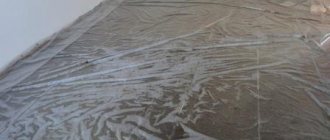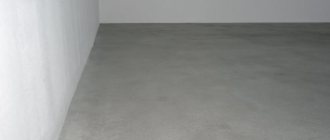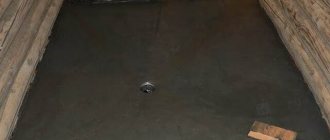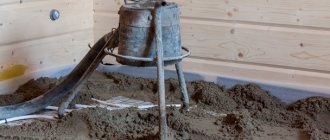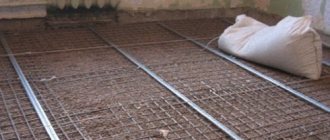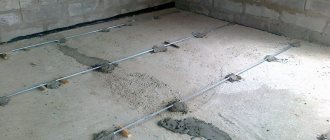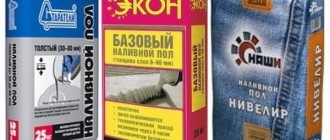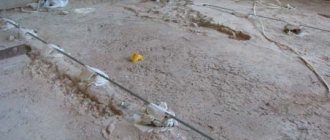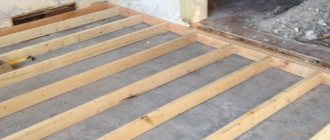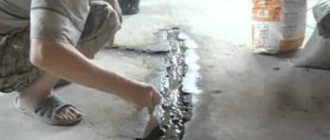Home |Construction |How to properly make a floor screed with expanded clay?
Date: September 20, 2017
Comments: 0
One of the most important construction operations when performing indoor renovation work is preparing the floor surface and its layout. The need to level the floor surface inevitably arises in old buildings and modern buildings in which the floor is not ideally flat. To accomplish this task, a floor screed with expanded clay is often used, which is the most affordable way to level the base. It’s easy to plan the surface yourself by deciding on a method of work that depends on the condition of the floor.
Expanded clay for screed - advantages of the material and feasibility of use
Expanded clay granules are a building material made from clay that has been fired at high temperatures. Granulated expanded clay particles have a spherical or oval configuration and are characterized by a porous structure.
Expanded clay is an environmentally friendly material, very light and practical, as well as very durable, with a high level of heat and sound insulation
The material for making screeds has a set of advantages, which is due to the properties of expanded clay granules:
- resistance to temperature changes. They retain their properties when cooled and heated and can be used in unheated rooms;
- the ability to soundproof a room, absorbing external noise. Thanks to the cellular structure of the granules, expanded clay filler effectively absorbs extraneous sounds;
- increased thermal insulation characteristics. The use of granular insulation allows you to reduce financial costs during the heating season;
- environmental cleanliness. The heat insulator is made from environmentally friendly and harmless raw materials and does not have a negative impact on the health of others;
- long service life. The granules retain their performance characteristics and porous structure for decades, providing effective thermal insulation;
- increased strength characteristics. Expanded clay flooring is not inferior in strength to a traditional cement-based floor, while ensuring moisture and air exchange.
Expanded clay screed combines increased strength and low weight. This allows you to form a reliable foundation, reducing the load on the floor slabs.
The material combines the soundproofing and heat-insulating properties of wood with the durability and strength of natural stone. This explains its widespread use for solving various construction problems, including the formation of floor surfaces.
Floor screed with expanded clay is one of the simplest floor leveling options
Certain situations arise when it is advisable to use the only possible option - expanded clay for screeding:
- with a significant difference in height in the room, amounting to 100–150 mm. The use of concrete in this situation will significantly increase the load on the floor slabs;
- if necessary, reduce the weight of the array. This is true for floors made of wooden beams that can only support limited loads;
- if there is a small amount of cement available and there is a desire to save money on the use of heavy building materials;
- in a number of technically justified cases related to the installation of various heating systems or the laying of utilities in the floor;
- when planning floor areas with complex terrain. With different layer thicknesses, it is important to ensure a low level of shrinkage, for example, for laying parquet.
Many developers who preferred expanded clay were convinced of the advantages of the material and its ease of use.
Basic properties and functions of floor screed with expanded clay backfill
In addition to the main problem that a screed with expanded clay solves - high-quality leveling of any, even problematic base, adding filler performs the following tasks:
- leveling;
- sound insulation increases;
- Such screeds provide excellent thermal insulation, which, in turn, reduces space heating costs. Therefore, insulating the floor with expanded clay under a screed is not only the simplest, but also the most profitable choice;
- Thanks to its porous structure, expanded clay prevents the room from overheating during the hot season.
Amorphous aggregate has a relatively low weight and density. But at the same time, the concrete layer provides good strength. The tandem of such building materials results in an excellent floor base, which not only puts minimal load on the floor, but also does not lose its characteristics during operation.
If we take a closer look at expanded clay and its properties, we can conclude that the porous structure gives the granules not only heat-saving characteristics, but also water-repellent properties. In addition, it is inert and has rare qualities - compatibility with any building material and ensuring a high level of adhesion.
Do-it-yourself floor screed with expanded clay is relevant in the following cases:
- when the base is made of reinforced concrete slabs;
- leveling the floors to the same level, provided their difference is more than 10 mm;
- if communications are hidden below;
- minimizing the concrete mixture;
- if heating is carried out electrically or infrared;
- low noise permeability.
Expanded clay
The screed is indispensable for obvious defects in the base, which can not only appear on the finishing coating, but also ruin it.
Screed with expanded clay - possible options
When planning the bases, the following methods are used to form the floor surface using expanded clay granules:
- prepare a cement-sand mortar, which is poured onto an expanded clay cushion. The technology involves preliminary distribution of material over the surface. Then the cement laitance is poured, which holds the bedding together. After pouring the finished composition based on cement and sand, it is stretched by the rule and formed towards the exit;
Expanded clay floor screed is very resistant to frost and extreme heat, therefore it is used in rooms with any conditions
- mix the granules with the sand-cement mixture, add water and fill the floor. This method is easy to implement and allows you to form an even base in a limited time. All ingredients are mixed in the required proportions with the addition of water to the required consistency. The process is completed by pouring and uniform distribution over the floor;
- the dry method involves preparing a mixture of expanded clay granules with sifted sand. The process is characterized by increased laying rates and allows the formation of an even base over larger areas. Dry filling technology allows you to prepare the floor without using cement mortar and avoid temporary losses associated with drying of the mortar.
Any of the selected methods, carried out in accordance with technological recommendations, will allow the base to be used for a long time without major repairs, will help create a solid base for the finishing coating, and will also ensure the safety of the utilities located under the expanded clay.
Advantages and disadvantages
Expanded clay floor screed does not lose its relevance due to the environmental friendliness and availability of the material. In an apartment or private house, expanded clay is used for thermal insulation under floor coverings due to the following advantages:
- Allows you to raise the floor level (especially when insulating the subfloor in private houses and cottages) and inhibits cold from the ground.
- Insulates reinforced concrete floors in apartments under which there are unheated (non-residential) premises.
- Excellent soundproofing of the room due to its porous structure.
- In case of unevenness and differences in floor level in the room, it allows you to level the surface very inexpensively, especially in comparison with concrete and ready-made screed mortars.
- It is inert to the formation of mold and rot, since it does not contain a nutrient medium for pathogenic organisms, which means you don’t have to worry about increased dampness and dangerous fungal spores that can harm human health.
- It does not create additional load on the floors, as it is a very light material.
- It is not flammable, which means it can be used to install heated floors. If a fire occurs in a room with an expanded clay floor, no harmful or toxic substances are formed during the combustion process. Also, in such a screed you can easily hide engineering structures and electrical wiring.
- Not afraid of temperature changes. Does not lose its properties both at low and high rates.
- Long period of operation. According to some reports, expanded clay is able to retain its properties for 30-40 years.
- Installing expanded clay screeds does not require special skills or complex tools.
- Moisture resistant. The water absorption coefficient ranges from 8-20%.
- Low cost and availability allows you to find this material in any, even small town or village.
However, in addition to the obvious advantages, floor screed made of expanded clay has some negative aspects. Among them:
- In most cases, the thickness of the expanded clay backfill is significant. As a rule, a layer of screed made of this material with a height of less than ten centimeters does not exhibit the properties necessary for heat and sound insulation.
- A dry screed, if moisture gets inside the expanded clay layer, can significantly aggravate the microclimate in the room. Although the granules themselves are impervious to water, the concrete coating located on top may be damaged.
Before giving preference to one or another material for floor screed, all the positive and negative aspects are carefully weighed. In the case of expanded clay, there are plenty of advantages, but the disadvantages are conditional and can be easily overcome if all the necessary standards for carrying out floor insulation work are observed.
Floor screed with expanded clay - preparatory stage
The quality of the formed base depends on the correct preparation of the floor surface. For any method of floor planning, it is necessary to carry out a number of activities to prepare the base.
Sequencing:
- Turn off electrical devices, water supply lines, remove furniture, freeing up the work area.
- Remove the previously made base, the final coat, as well as oil traces and greasy stains.
Any screed must be laid on a carefully prepared surface - Remove construction debris from the premises and dust the surface using a vacuum cleaner.
- Seal cracks, fill them with cement or putty, and plan for significant elevation changes.
- Impregnate the base with a sealing compound that will increase adhesion and reduce dust formation.
- Make markings using a building level, determining the coordinates of the location of the base being formed.
- Cover the surface with a waterproofing material that provides reliable protection from moisture.
- Install, if necessary, a metal reinforcement frame or a special mesh that increases the strength characteristics.
Having completed the preparatory work, proceed to carry out activities according to the chosen method of work.
Expanded clay screed - how to mark and install beacons
To form an even coating located at the same level, it is necessary to take a responsible approach to marking and installing guides (beacons).
To begin marking work, you need to prepare:
- building level;
- pencil or marker.
The first stage is marking the floor and installing beacons for floor screed
Sequence of operations:
- Draw marks on the surface of the walls of the room, the level of which corresponds to the thickness of the layer of the future base.
- Check that the markings are done correctly, as well as the coincidence of the lines drawn according to the markings in the corner areas.
Install beacons according to the following algorithm:
- Cut the screed beacons to the required length, corresponding to the size of the room.
- Install profiles at intervals of 0.6–0.8 m.
- Fix the beacons with cement mortar or alabaster.
After correctly marking and fixing the beacons, you can carry out the filling work.
Which one is better for screeding?
Expanded clay is added to the screed to increase the thermal insulation properties. Depending on the size of the granules and the area of the room where backfilling is carried out, on the thickness of the floor screed, the most suitable one with the required fraction of granules is selected.
The screed in a normal room does not exceed 30 mm in height. In this case, it is advisable to use 1 and 2 fractions. If the screed exceeds 40 mm, granulate with a diameter of 20–40 mm is taken.
Depending on the density of expanded clay, it is also used in suitable conditions. In total, there are 10 density grades (from 250 to 800). 1 m3 of M-250 brand weighs 250 kg. It is important to know this point in order to make the screed as light as possible.
Expanded clay screed - pouring technology
Before starting activities to form an expanded clay floor, it is necessary to choose a pouring method and study the technological nuances.
The most common options for expanded clay flooring are:
- filling the base with a concrete-sand composition poured onto expanded clay granules;
- concreting the floor with cement mortar, into which expanded clay is introduced when mixed.
Let us consider in detail the technology for performing work for each option.
After preparing the coating and installing the beacons, dry fine-grained expanded clay is scattered over the entire base
How to calculate expanded clay for floor screed
Before starting repairs or construction, each person tries to make approximate calculations of upcoming costs. In order to do this, you need to know how much materials will be needed for certain jobs. In particular, you can easily calculate the volume of concrete for an expanded clay concrete screed, but we will consider how to determine the amount of expanded clay below.
First of all, you need to find out which layer is needed for proper heat and sound insulation:
- 1. In the case of an apartment in a multi-storey building, the thickness of the expanded clay layer should not exceed 4-5 cm. It is necessary to take into account the height of the ceilings and the fact that there is a warm room below. Expanded clay concrete screed in this case is needed as sound insulation and it does not put a large load on the floor slabs.
- 2. First floors, private housing construction, basements require a minimum of 10 cm layer of dry expanded clay, not counting the screed. Otherwise the floor will be cold.
- 3. The ceiling under the roof does not require a concrete covering, but it must be insulated and it is advisable to do this using expanded clay. The minimum layer thickness for buildings in the middle zone should be 20 cm. In warmer regions, the layer can be reduced. The main thing to remember is that if the ceiling is insulated, a vapor barrier must be laid under the expanded clay layer.
By carrying out simple arithmetic calculations, it can be revealed that per 1 m2 a minimum of 0.04 m3 of expanded clay is required with a filling layer of 4 cm. But as practice has shown, this is not enough. There is construction expanded clay available for sale, packaged in 50 liter bags. It is just enough for 1 m2 of area with a minimum layer of 4 cm.
The calculations never take into account floor unevenness, various chips and potholes, so when following mathematical calculations in construction, always allow an error of +5-10%.
Expanded clay screed - pouring sand-concrete mortar onto prepared granules
This method of performing work involves pouring a mortar made from a mixture of cement and sand onto a previously poured expanded clay cushion.
Carry out work to form the foundation, guided by the given procedure:
- Determine the area with the maximum height from which the filling of expanded clay granules will begin.
- Fill it with granules and, following the markings, distribute the material throughout the room.
- Check the correct distribution of the material, ensuring a distance of 15–20 mm to the edge of the profile.
- Prepare cement laitance by mixing water with cement and pour it evenly over the expanded clay mass.
- During the day, ensure the absence of mechanical influences for the final hardening of the laitance.
- Prepare the mixture for pouring, following the standard recipe, or use a ready-made commercial solution.
- Fill the base, gradually moving from the far wall towards the exit.
- Stretch the mixture gradually with a long rule, which is pressed against the surface of the beacons during the work.
- Allow the poured solution to remain stationary for three weeks to complete the hydration process.
- Periodically moisten the surface of the formed array with water to maintain the required level of humidity.
Mix the solution in small quantities, apply it to the prepared expanded clay base and level it
After final hardening of the composition, you can begin further work on surface treatment and application of the finishing coating.
Expanded clay screed with pouring a mixture of sand, concrete and expanded clay
A feature of this pouring method is the addition of expanded clay granules to the mixture at the stage of preparing the solution, which can significantly reduce the duration of the work.
Prepare concrete mortar with granular filler in the following order:
- Pour granulated expanded clay into the working container, add water, mix thoroughly until the moisture is completely absorbed.
- Pour in the cement-sand mixture, mix again until smooth using a construction mixer.
- Place the resulting mixture on the prepared base, carefully level it as in the previous version.
- Do not subject the hardening solution to mechanical stress; moisten it regularly with water.
This method of performing work is simple. It allows you to pour the screed layer by layer depending on the prepared amount of working solution. The use of special plasticizers added at the preparation stage avoids cracking during solidification.
Features and methods of using this material
Expanded clay is a very high quality material. This is the reason for its popularity. It has a clear production technology from foamed clay, and manufacturing involves exposing the material to high temperatures. After firing, light and high-strength granules with a water-repellent shell are obtained. The bubbles inside the material increase the thermal insulation characteristics of expanded clay.
Expanded clay is classified according to the size of the resulting granules:
- Small. Its diameter does not exceed 1 cm.
- Average - from 1 to 2 cm.
- Large. Diameter - more than 2 cm.
Depending on the type of base on which the material will be used, the category of expanded clay is chosen. Small granules increase the weight of the structure. It is used for sprinkling difficult areas that require the least deformation during operation, or to create a flat, durable base for block parquet.

